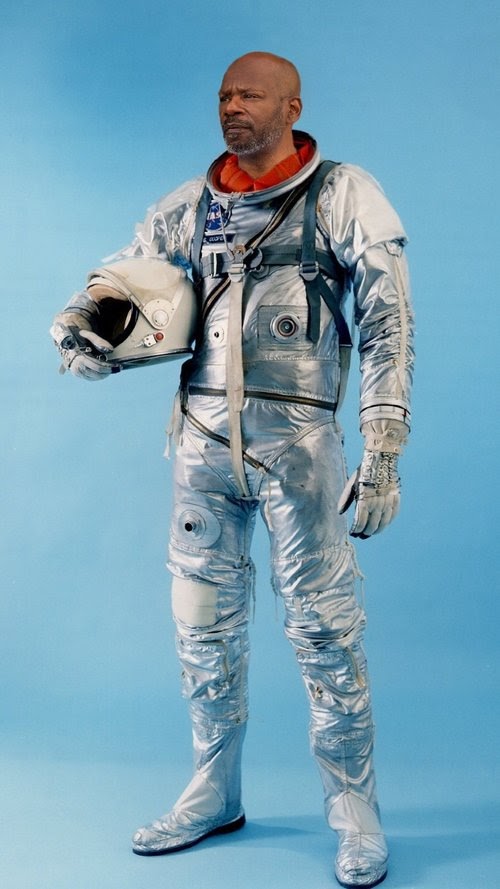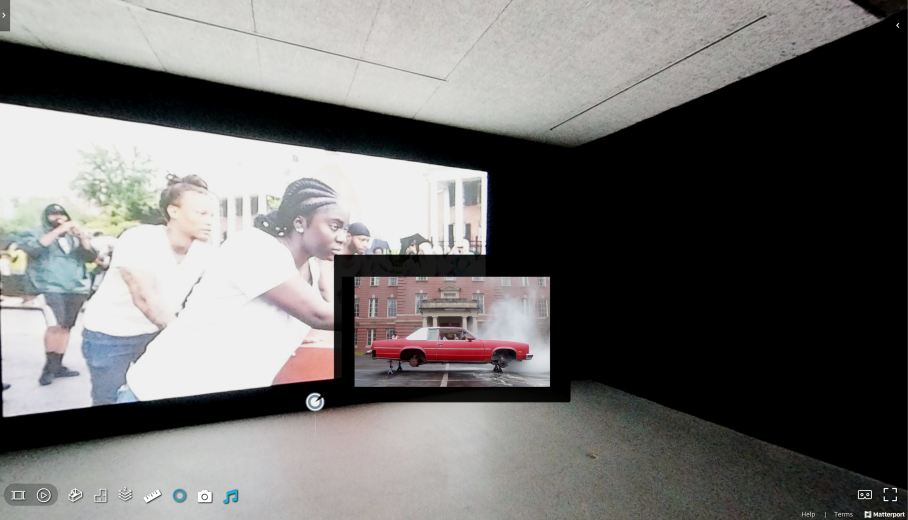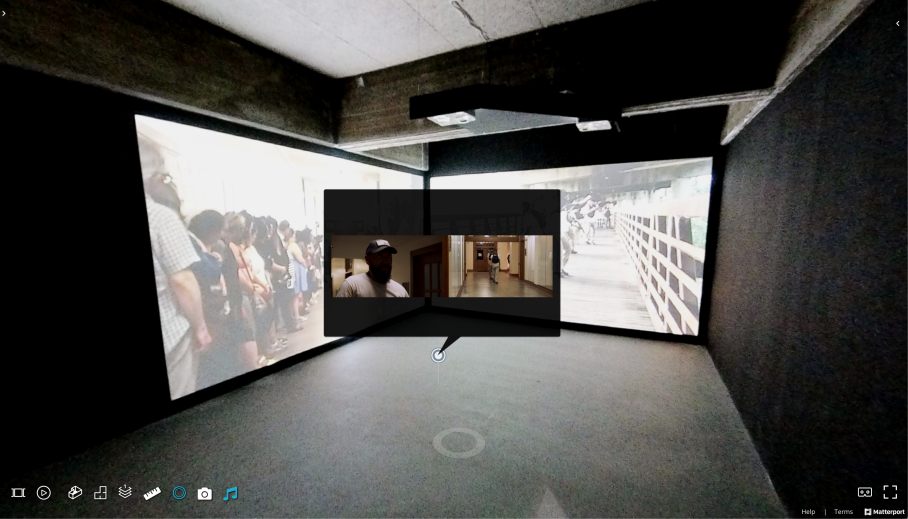Examining Identity Through Art
Inspiring Conversations Around Race and Struggle

The San Francisco Art Institute (SFAI) and Aggregate Space Gallery (ASG) in Oakland have joined forces to present “Flash Point,” the work of a Chicago-based interdisciplinary artist, Jefferson Pinder. Evoking the violence of the Red Summer of 1919, “Flash Point” takes us on a journey to explore what happened over one hundred years ago and how it still has a tremendous impact today. Through his incredible performance work captured through video, Pinder vividly brings forth the events and emotions of the past.
Viewers are invited to experience the exhibition from anywhere in the world as it was originally presented in the Walter and McBean Galleries by watching the full length video works, reading about the works in detail through wall texts, and wandering the gallery. The Matterport 3D tour of this exhibition was captured with the Insta360 camera.
Like many arts and education-based organizations, SFAI is working to envision the future of arts engagement in a way that better utilizes technology and increases access to a global audience. Through collaborations with radical thinkers across disciplines, SFAI will continue to place artists at the center of future making.
We connected with the Aggregate Space Gallery and Jefferson Pinder to hear their stories behind the exhibition.
Tell us about your Red Summer Road trip in 2019 and how it inspired “Flash Point?”
Jefferson: Well, Flash Point is the documentation of the Red Summer Road Trip of 2019. The idea of the road trip was inspired by my fascination about one of the most turbulent times in US history that the general public seemed to know very little about. Young black men were being killed during the Summer of 1919 at an epic scale. Black soldiers were returning in masses from victorious combat campaigns in Europe. Black bodies were weaponized by the US government, and in subsequent years, African-Americans fought and resisted oppressive forces throughout the nation…. Uprisings (“riots” as they were called) happened in dozens of locations around the country including: Chicago Washington, DC and Elaine, AR to name a few.
My crew and I began the journey in early spring with the production of “THIS IS NOT A DRILL.” This piece was a devised performance work that was shown at the Chicago Cultural Center. It wrestled with the militarization of the Black body and the preparation for an ‘inevitable conflict.’ It was an intense performance in which spectators watched a small team of Black performers begin a brutal indoctrination of training to fight and kill.
This was a huge mental challenge. We had United States Marine Corps veterans work with us to prepare. This is how the tour began. Similar to Student Non-Violent Coordinating Committee (SNCC) workshops in the civil rights era, we had to ready ourselves for this southern tour.
After Chicago, we proceeded to cities and locations that were sites of violence and protest during Red Summer. We explored history, time and space. Each of these sites have a tragic history – we explored and desperately tried to find artistic poetry between the past and present.

What is one thing you want viewers to take away from the exhibition and why?
Jefferson: I want viewers to understand the delicate balance between history and the present. I want viewers to ambitiously ask questions about how these events a hundred years ago affect who we are today. I want viewers to understand the role that art has to help us look and examine these forgotten histories.
How do you see the role of art as we fight for greater equality in our society?
Jefferson: W.E.B. DuBois told us that art can and should be used as a way to examine identity. Even in a white-walled art gallery, equality doesn't exist. I would love to paint a pretty picture, but personally I don’t know how to do that. For many Black artists, we have not been afforded that freedom. We begin this fight for equality in our society here, in these art spaces.
As the art world moves increasingly toward virtual, what has been your experience presenting exhibitions in this way?
ASG: Since our launch in 2011, Aggregate Space Gallery has provided a platform annually for around ten exhibitions, a number of special lectures, film screenings, literary events, and performances every year. We are an institution built on the idea of immersive, large-scale, and “in-person” art experiences – that prioritize the exhibition of artwork that generally can’t be seen elsewhere. Our mantra is “Install the Unimaginable.” Our founding location was designed to generate the most exceptional museum-like experiences of visual art possible.
The turn toward the virtual during COVID-19 pandemic has challenged our view of what it means to participate in art that is beyond human scale. Currently, the Matterport scan has allowed us one of the most immersive offsite experiences we could have ever imagined. To see Pinder’s exceptional work have this additional opportunity to find an audience is a relief, especially after his exhibition was cut short due to the pandemic. To that end, we look forward to scheming new ways to imagine experience-based, new media art installations via virtual reality. ASG will continue to be focused on being a community for artists that is unifying and empowering, using all of our in-house expertise to bring daring works of art to life with programming that elevates diverse creative, new, and unheard voices of artists, writers, and scholars.

We learned Aggregate Space Gallery has been displaced from its location in Oakland. How have partnerships with SFAI, coupled with presenting satellite and virtual exhibitions, helped cope with uncertainty?
ASG: ASG was only displaced through the latter half of 2019, we actually had found a new location, not too far from our original location in West Oakland. Partnering with the San Francisco Art Institute on this exhibition was a great way to continue ASG’s programming and to give much needed time and space to this important exhibition by Jefferson Pinder.
Prior to the COVID shelter-in-place order in Oakland, we were weeks away for our big gala fundraiser which was to act as a relaunch of our new space and a reintroduction to the work we had done planning for our new future. This event, as well as all of our forthcoming “in-person” events, have been postponed indefinitely. We have dabbled with online content through our annual animation festival, which was live on our YouTube page for 2 weeks in July/August. ASG’s director and co-founder Conrad Meyers created an online chat series called “This New Idea” to cope with the new and difficult conversations about ideas amongst the pandemic.
The San Francisco Art Institute works to support the Bay Area arts community and beyond through partnerships with local and international institutions. Partnering with Aggregate Space Gallery gave SFAI the added opportunity to further support SFAI alumni and co-founders Conrad Meyers and Willis Meyers who continue to provide much needed space and support for artists who are experimental and risk taking in their thinking and exhibition making.
SFAI thanks its partner ASG, the artist Jefferson Pinder, and Matterport for their ongoing support in making this virtual exhibition possible.
The original exhibition was on view December 6, 2019—March 28, 2020 in the Walter and McBean Galleries at SFAI—Chestnut Street Campus.
For more information, please visit SFAI, ASG and artist Jefferson Pinder at:https://sfai.edu/https://aggregatespacegallery.org/http://www.jeffersonpinder.com/
